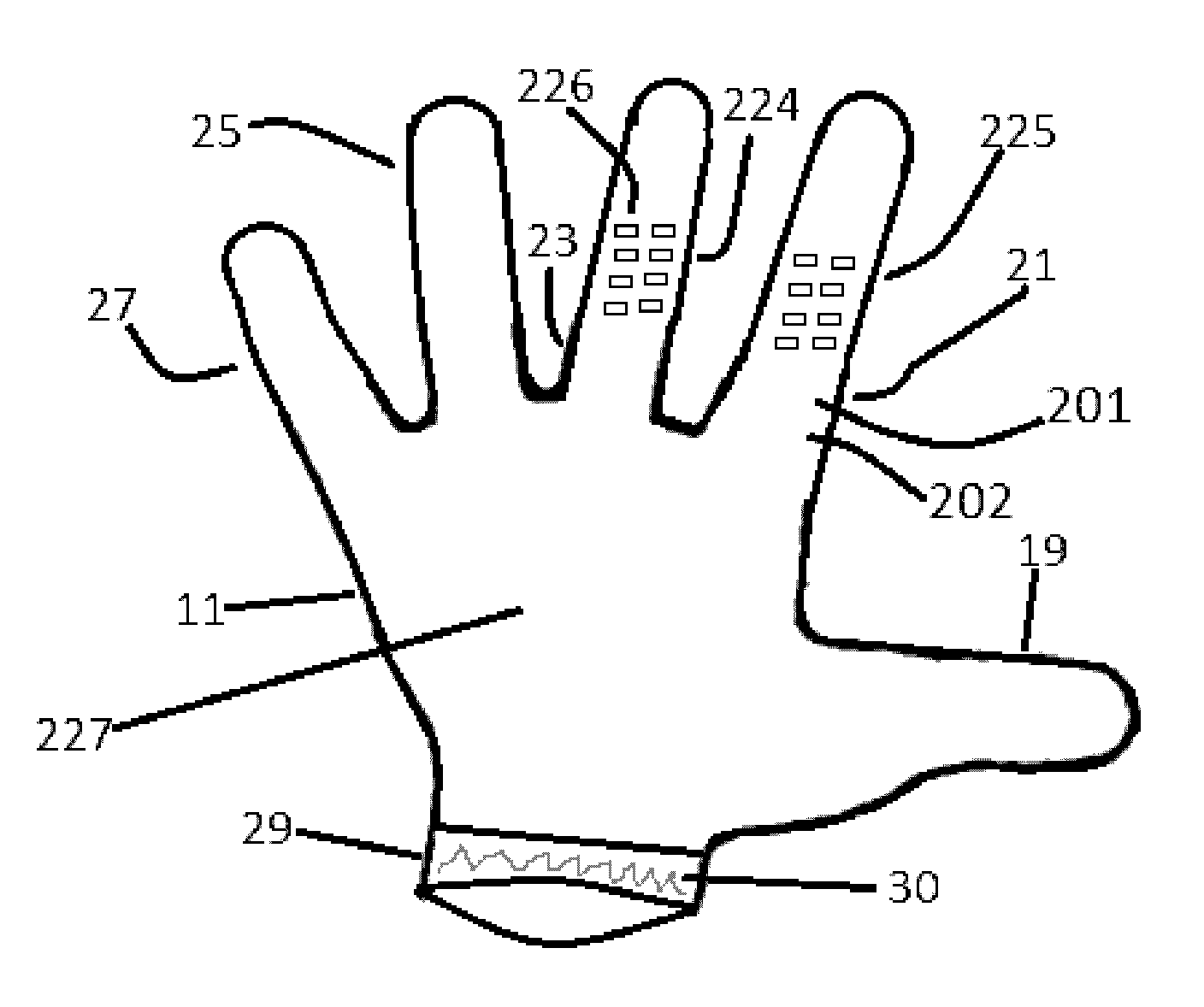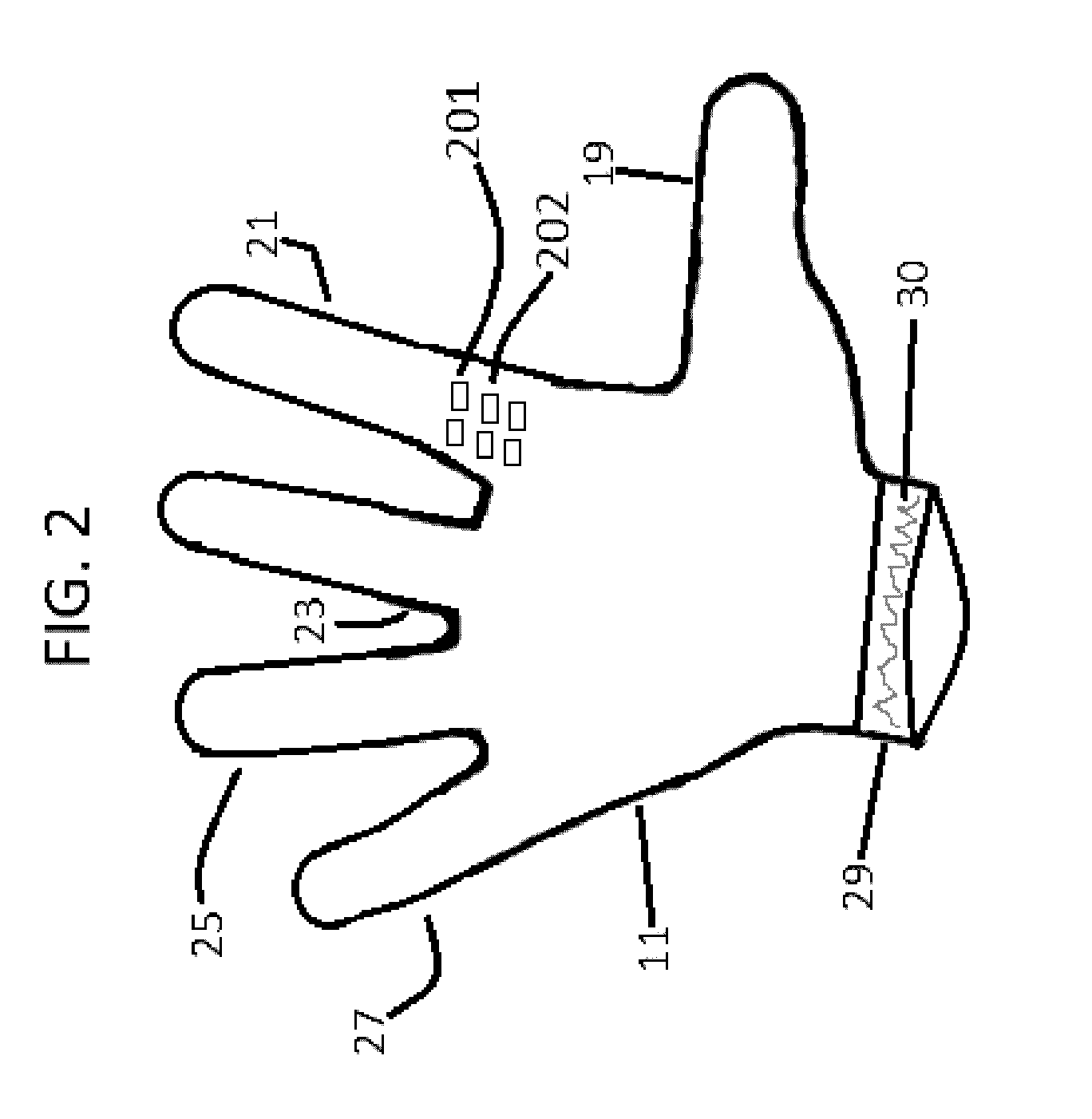Golf gloves
a technology for golf gloves and gloves, applied in the field of golf gloves, can solve the problems of prior art limitations, hindering the achievement of the effect, and affecting the performance of the golf glove, so as to improve the grip capability, minimize even a modest amount of unnecessary movement, and improve the grip capability
- Summary
- Abstract
- Description
- Claims
- Application Information
AI Technical Summary
Benefits of technology
Problems solved by technology
Method used
Image
Examples
second embodiment
[0127]FIG. 3 is a drawing of the palmar view of a second embodiment, where the pinkie finger palmar digital segment comprises a grip enhancing means;
[0128]FIG. 4 shows the top and bottom view of a panel which creates a higher friction surface on an embodiment, as shown in FIG. 3.
[0129]FIG. 5 is a drawing of the embodiment as described in FIG. 3, showing the dorsal view, where the region between the middle finger and a user's forefinger comprises a grip enhancing means; the side of the middle finger proximal phalanx segment comprises a grip enhancing means; and portions of the dorsal segment on, around and between the glove overlaying the forefinger and middle fingers metacarpophalangeal joints of this embodiment comprises a grip enhancing means, all in the form of PVC dots.
third embodiment
[0130]FIG. 6 is a drawing of the palmar view of a third embodiment, where a grip enhancing means also comprises high friction surfaces on the palmar surface of the pinkie segment, and on the palmar surface of the forefinger segment.
[0131]FIG. 7 is a drawing of the embodiment as described in FIG. 6, dorsal view, where a grip enhancing means is also provided on the side surface of the forefinger's proximal phalanx adjacent the middle finger segment, on the side surface of the forefinger's proximal and middle phalanges adjacent the thumb segment, on the dorsal surface of the forefinger segment, and on the side surface of the thumb segment.
[0132]FIG. 8 is an alternative dorsal segment to FIG. 3.
[0133]FIG. 9 is an alternative dorsal segment to FIG. 6.
[0134]FIG. 10 shows a typical interlocking grip using a conventional prior art glove.
[0135]FIG. 11 shows an alternative dorsal segment to FIG. 1.
[0136]FIG. 12 shows a second alternative dorsal segment to FIG. 3, where a grip enhancing means ...
embodiment 244
[0283]These surface areas may include a depression or projection pattern formed from a high friction material, or any other form or structure aforementioned. Formed on the illustrated embodiment is a plurality of oval-like depressions 280, 281, 265, 266, 271 that are applied to select areas of the embodiment by any standard means, as aforementioned, defining the respective boundaries. These oval-like depressions preferably are spaced apart to allow for added grip and flexibility. Thus, this embodiment comprises a grip enhancing means throughout the entire forefinger segment of the embodiment 244.
[0284]Preferably, the depths of the embodiment's grip enhancing means are such that the gap formed by the depressions allow for some movement of the affected surfaces thereby increasing the grip capabilities of the user. The depth can generally begin at about one hundred micrometers to several millimeters or more. For example, these depressions are about two hundred micrometers in depth, abo...
PUM
 Login to View More
Login to View More Abstract
Description
Claims
Application Information
 Login to View More
Login to View More - R&D
- Intellectual Property
- Life Sciences
- Materials
- Tech Scout
- Unparalleled Data Quality
- Higher Quality Content
- 60% Fewer Hallucinations
Browse by: Latest US Patents, China's latest patents, Technical Efficacy Thesaurus, Application Domain, Technology Topic, Popular Technical Reports.
© 2025 PatSnap. All rights reserved.Legal|Privacy policy|Modern Slavery Act Transparency Statement|Sitemap|About US| Contact US: help@patsnap.com



